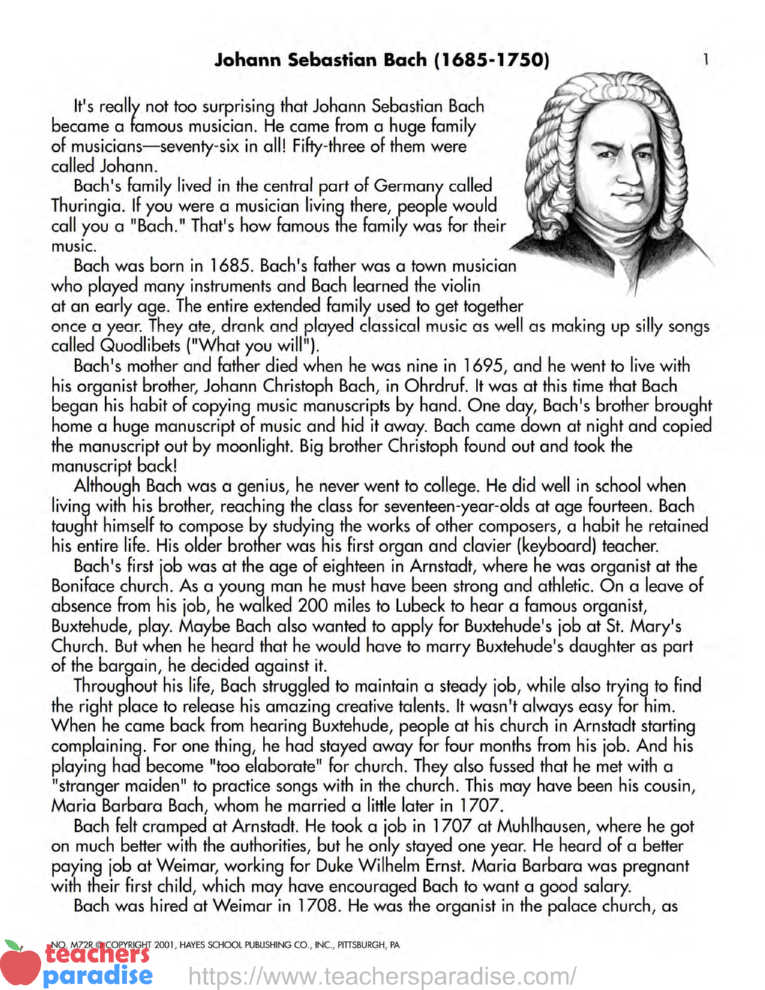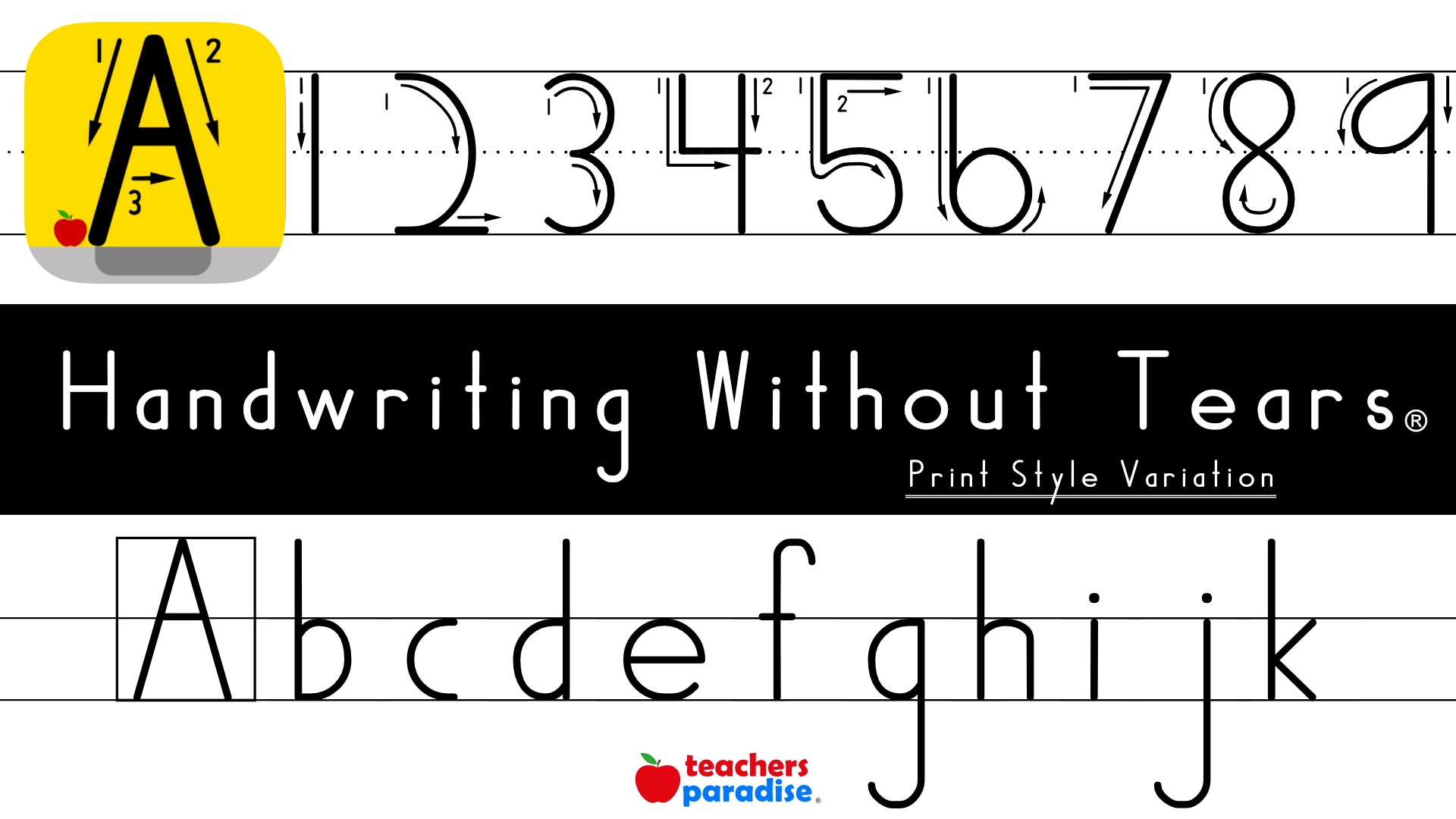Famous Composers and Their Music
TABLE OF CONTENTS
Johann Sebastian Bach – 1-6
George Frideric Handel – 7-14
Wolfgang Amadeus Mozart – 15-21
Ludwig Van Beethoven – 22-29
Franz Peter Schubert – 30-36
Robert Alexander Schumann – 37-43
Felix Mendelssohn Bartholdy – 44-50
Fryderyk Chopin – 51-57
WORKSHEET & Sample PDF Activity
Sample PDF Activity
It’s really not too surprising that Johann Sebastian Bach became a famous musician. He came from a huge family of musicians—seventy-six in all! Fifty-three of them were called Johann.
Bach’s family lived in the central part of Germany called Thuringia. If you were a musician living there, people would call you a “Bach.” That’s how famous the family was for their music.
Bach was born in 1685. Bach’s father was a town musician who played many instruments and Bach learned the violin at an early age. The entire extended family used to get together once a year. They ate, drank and played classical music as well as making up silly songs called Quodlibets (“What you will”).
Bach’s mother and father died when he was nine in 1695, and he went to live with his organist brother, Johann Christoph Bach, in Ohrdruf. It was at this time that Bach began his habit of copying music manuscripts by hand. One day, Bach’s brother brought home a huge manuscript of music and hid it away. Bach came down at night and copied the manuscript out by moonlight. Big brother Christoph found out and took the manuscript back!
Although Bach was a genius, he never went to college. He did well in school when living with his brother, reaching the class for seventeen-year-olds at age fourteen. Bach taught himself to compose by studying the works of other composers, a habit he retained his entire life. His older brother was his first organ and clavier (keyboard) teacher. Bach’s first job was at the age of eighteen in Arnstadt, where he was organist at the Boniface church. As a young man he must have been strong and athletic. On a leave of absence from his job, he walked 200 miles to Lubeck to hear a famous organist, Buxtehude, play. Maybe Bach also wanted to apply for Buxtehude’s job at St. Mary’s Church. But when he heard that he would have to marry Buxtehude’s daughter as part of the bargain, he decided against it.

Throughout his life, Bach struggled to maintain a steady job, while also trying to find the right place to release his amazing creative talents. It wasn’t always easy for him. When he came back from hearing Buxtehude, people at his church in Arnstadt starting complaining. For one thing, he had stayed away for four months from his job. And his playing had become “too elaborate” for church. They also fussed that he met with a “stranger maiden” to practice songs with in the church. This may have been his cousin, Maria Barbara Bach, whom he married a little later in 1707
Bach felt cramped at Arnstadt. He took a job in 1707 at Muhlhausen, where he got on much better with the authorities, but he only stayed one year. He heard of a better paying job at Weimar, working for Duke Wilhelm Ernst. Maria Barbara was pregnant with their first child, which may have encouraged Bach to want a good salary.
The Duke was a religious man and loved Bach’s music. Bach began writing cantatas for the Lutheran church services held each week. The cantatas were vocal pieces for solo voice and chorus, and were based on German hymns. During the Weimar years, Bach also wrote many now-famous works for organ including the well-known “D minor Toccata and Fugue.”
Bach was happy working at the court of Weimar, until the Duke quarreled with his nephew in 1716 and forbade his employees to see him. Unfortunately, Bach was very friendly with the nephew, and a growing tension ensued between Bach and the Duke. This may have been the reason why Bach mysteriously stopped writing a planned cycle of cantatas.
Finally Bach demanded to leave his job at Weimar. The nephew had told Bach about the job of kapellmeister (director of music) for the Prince of Anhalt-Cothen. In a fit of temper, the Duke threw Bach into jail for a month for daring to ask. Bach and his family finally arrived at Cothen in 1717, where they were treated well. Bach wrote many chamber music pieces with instruments only for the Prince’s social gatherings. He also wrote the famous Brandenburg Concertos. A concerto is a piece of music where a small group of instruments is contrasted with a larger group of instruments.
A great sadness during this happy period in Bach’s life was the untimely death of his wife, Maria Barbara, in 1720. She had borne him seven children, including future composers Wilhelm Friedemann and Carl Philipp Emmanuel. Bach was despondent for a while, but, thinking of his small children, began to look for another wife. He married Anna Magdalena in 1721. Anna Magdalena was a singer at the Prince’s court and copied out a lot of Bach’s music. It was for this second wife that Bach wrote “The Anna Magdalena Notebook,” a collection of beginning keyboard pieces that piano students play to this day.
In 1721, the Prince of Cothen married a Princess who hated music, which was a blow for Bach. Gradually, attendance fell off at the chamber music gatherings that Bach had conducted with such pride, and he reluctantly looked around for another position. He found one at St. Thomas Church in Leipzig. There was a good university in Leipzig, and Bach wrote to a friend that he needed to start thinking about his sons’ education. The job of kantor at St. Thomas Church involved an immense amount of work. The kantor had to write cantatas for the church services and train the students of St. Thomas School in singing. He also had to oversee the music of the entire town of Leipzig, which had 30,000 people.
Bach liked some parts of his job at the St. Thomas Church, but not others. For one thing, the students he had to train weren’t very talented musicians, and were not able to perform many of Bach’s pieces. The council men who hired Bach didn’t really recognize his genius and accused him of neglecting his job duties.
However, Bach did have a creative outlet when he performed with college students in Zimmermann’s coffee house for special occasions in Leipzig. This group of college students was known as the Collegium Musicum. In honor of the fun evenings spent at the coffee house, Bach wrote a cantata known as the Coffee Cantata.
Bach’s sacred works from this period include the St. Matthew Passion, the St. John Passion, and the great B minor mass. He also wrote over 300 cantatas. Bach died in 1750. He was very famous within Germany, but did not have the international fame that he has today. Part of the reason for his lack of reputation was that he wrote in an old-fashioned way called “polyphony” (many voices) that was going out of style.
In the weeks before his death, he completed his monumental work “The Art of the Fugue.” This work was like a summary of all he had achieved in fugal writing. In it, Bach took one theme and set it polyphonically (with many voices) in every way imaginable.

Questions for Study and Discussion:
- How old was Bach when his parents died?
- Where was Bach’s first job?
- Name some reasons why people at the church in Arnstadt were angry with Bach.
- What happened when Bach asked the Duke of Weimar to leave his job?
- What kind of pieces did Bach write for the Prince of Anhalt-Cothen?
- What were Bach’s duties at St. Thomas Church?
- Name three of Bach’s works.
- Why was Bach not all that famous when he lived?
























